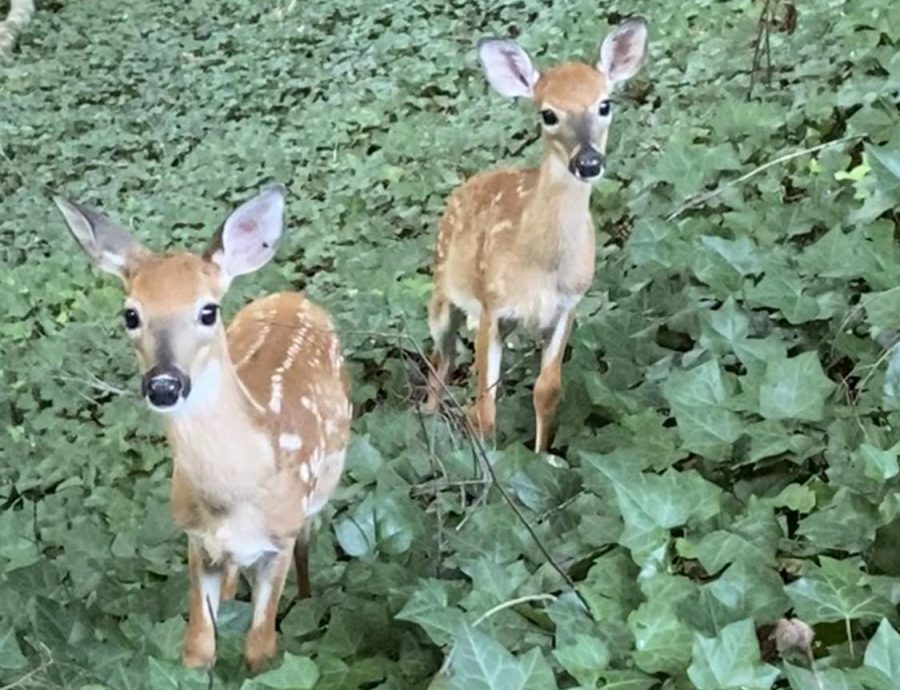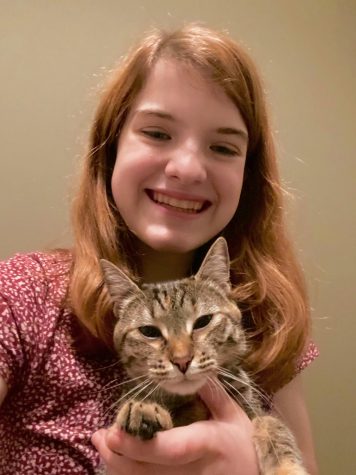Dear Deer, Steer Clear: Why Deer Need More Respect, Less Danger, and More Conservation
Photo courtesy of Catherine Cossaboom.
Two fawns in the forest near Murphey Candler Park.
October 30, 2020
It was late August, and I was taking my third walk of the day. Up and down the street, around the back of Murphey Candler Lake and through the Kittredge Magnet School field and cul de sac, it was a route I had walked hundreds, if not thousands, of times, seeking little spaces of refuge in my busy day, and I was pretty much on autopilot, dangerously checking my phone while walking through the least scenic part of the neighborhood.
Suddenly, I heard a clanking noise, faint in volume but desperate in quality. Clank! Clank! Looking wildly around for the machinery or rambunctious kid that could be creating such a harrowing sound, my eyes happened to land on a gruesome sight. Clank!
A deer, punctured with one back leg on a spiky metal 10-foot-tall fence, bleeding out into the grass below, frantically struggling for its freedom. Clank! Clank! You could immediately tell how much pain the animal was in—and how desperate it was for its release, as its front hooves pounded against the metal. Clank!
In shock, I paced back and forth on the street, calling my mom to the scene, and together, we were forced to call 911—the animal hotline was closed, apparently due to budget cuts from COVID-19. Clank! Clank!
In the twenty minutes it took for the designated officer to arrive, the animal had been struggling more and more rapidly, accelerating its tormenting contact with the fence, and the severity of its own wound. Not only that, but in that time, the nextdoor neighbor proclaimed something derogatory about the presence of the deer in the neighborhood, and the homeowner himself, while trying to be “helpful,” ignorantly tried to shovel the animal off the fence, causing it to cry out in pain. Clank! Clank!
The frank disregard for the wellbeing of the animal, in favor of its speedy removal from the property, and the lack of resources or timeliness in DeKalb’s animal response, shocked me almost as much as the distressing scene itself. My mom and I seemed to be the only ones involved who genuinely cared about how terrible of an experience the deer itself was having; everybody else simply wanted to remove a “hassle” and get on with their day.
Unfortunately, I’m not sure how this story ends. Once arrived, the animal officer never stopped to explain himself, and simply took out a gun. We had to drive away at this moment, but as I heard the clanks retreat into the distance, I could only hope that the gun was a tranquilizer gun, not a lethal one. But what other help could I have called in? Clank! Clank. Clank…
This was not my first experience with the deer of Murphey Candler. Over the six months of quarantine (and the years before), I had become well-acquainted with the animal residents of the lake. Two fawns and their mother had approached me numerous times in the backwoods, so close that they violated any sort of “six-foot quarantine guideline,” and that very day, earlier in my walk, I got close enough to a pair of deer to take a selfie with them.
Always kind and always a calming presence, seeing the deer revitalized me, as I understood that their simpler way of life was one of tranquility and appreciation—when they weren’t trying to protect their young from the countless human-caused threats around them.
Of course, these threats are not always easy to avoid. Sprawling suburbs come with all sorts of hazards, and urbanization has pushed the deer onto merely a few hundred acres around the 2-mile loop of Murphey Candler Lake and some of the connecting backwoods.
Even if one is an animal lover, it is unlikely that a new homeowner would think about removing a spiky iron fence to support the deer population, especially when removal of one would likely be a substantial additional cost without any added function.
But, I will argue that we should be more aware of the deer among us, that we should shape our mindsets towards supporting them and considering them in our actions, and that the county should provide a substantially larger set of resources towards conserving, not curbing and controlling, the animal population among us.
It seems odd to me how easily my neighbors can be in awe of the deer, taking pictures, pointing them out to one another, and trying to approach them, but yet can be so apathetic about their fate. When I was with the injured deer, dozens of people flooded by on the street, uninvolved, despite the obvious clatter beside them. A few days later, I found a crowd surrounding a group of deer just a few hundred feet up the road, with everyone exclaiming excitedly over their white tails and emerging antlers. To me, it seems incredibly hypocritical to gawk over the animals among us like tourists, but to do nothing that benefits them, especially when a call-to-action is so direct.
My argument here spans beyond simply mindsets, however. I think it’s extremely important for us all to keep an eye out for the deer and to take actions that benefit them, like removing obvious spiky or chemical hazards in our yards and watching out for them on the streets, but I understand that such individual notions are rarely effective arguments—and rarely lead to effective change.
Take legislation for example. State hunting laws in Georgia allow deer to be hunted on any public property, a statute that cannot be restricted by localized areas, like cities and counties. Though DeKalb is an archery-only county, it is still perfectly legal for anyone to kill a deer just outside a property line, and even in that property line, if the homeowner gives permission.
On the other hand, there are very few deer protection laws in Georgia and the few that do exist concern hunting: that you cannot kill a deer in a lake, for example. By no means are there laws that protect deers from any suburban hazards—the only legislation that exists simply protects them from being killed in areas that aren’t convenient for humans!
We need more laws that support animals, rather than considering them only as objects to be hunted for sport or removed for convenience.
Hunting is often justified by claiming that the deer population is too large as it is. Without natural predators, there are many more deer than theoretically there would be, and the population needs to be controlled. While there are merits to such an argument, it isolates itself from the larger context. The deer population in Georgia is estimated at a number that is only about 13% of the total human population of the state, and that, of course, includes much more rural areas than those in metro Atlanta, where the proportion is likely much lower.
The human population is therefore much, much more dominant than the deer population, and it shouldn’t be beyond us to afford some sort of compassion for a species that has reduced in numbers significantly from what it would have been without the influence of urbanization. If one is to argue that deer are an “invasive species” because their predators are not in check, can the same not be said of humans?
All in all, we need to fight for laws that exemplify hazard removal and conservation for animals, including regulations on newly-built fences and yards that are not dangerous for deer. We need an animal office in DeKalb that is fully staffed, with a readily available hotline, and that has more than just a few connections to local shelters and rehabilitation centers, so that the first concern of an animal officer is keeping the animal alive and eventually, returning it to the wild—not simply removing an inconvenience for a homeowner.
There are species on this planet other than ourselves. Even if one doesn’t want deer in their yard for the safety of their plants, this is no reason to hunt them, ignore them, or afford no empathy towards them. Simply set up wooden fences that cannot harm the deer, and seek to plant plants that deer naturally avoid. By directing them away from the house, you direct them naturally back into the woods, where it is, after all, safer, and the deer gain a helping hand in the mildness and lack of aggression in your response.
Above all, we need to stop condoning the mindset that deer are a problem to be dealt with—so much so that the concern overwhelmingly overtakes conservation across local, state, and national agendas—but rather a population to be cared for, respected, and treated with the same empathy and joy in our neighborhoods that we receive every time we notice them in the wilderness, gracefully leaping with contagious contentment.
This article is part of a pair of opposing opinion pieces. The opposing side can be found here.











